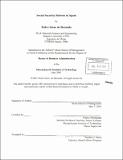Social Security reform in Spain
Author(s)
Sainz de Baranda, Pedro, 1963-
DownloadFull printable version (49.61Mb)
Other Contributors
Sloan School of Management.
Advisor
Franco Modigliani.
Terms of use
Metadata
Show full item recordAbstract
The Spanish public pension system is currently based on the pay as you go (PA YOO) principle. This thesis examines the current structure of this public system and its financial viability in the face of expected demographic changes. First, demographic and macroeconomic models were created extending out to 2050 and, based on them, the finances of the system were estimated assuming that the current regulations would remain largely unchanged. The simulations indicate that the system will show small surpluses for the next years followed by an alarming deterioration beyond 2020, mainly driven by demographic factors such as increasing life expectancy and the reduction in fertility rate observed in the last two decades. The baseline demographic and macroeconomic scenario results in a projected deficit of about 7% of GDP by 2045. This outlook includes a reduction of unemployment and an increase in labor force participation within reasonable limits. It is also shown that high immigration, fertility and productivity growth, again, within reasonable limits, while improving the financial outlook, do not resolve the issue. Without significant reforms, the system will be faced with a reduction in benefits and/or an increase in the payroll-tax by the second quarter of this century. The model is further used to test the effectiveness of potential reforms. We conclude that a permanent solution could be supported on three pillars: 1. The creation of a Pension Fund with the surpluses of the PAYOO system and a creative investment policy such as that recommended by Modigliani et al. 2. The contribution of the prospective surpluses from the unemployment system (INEM) to the fund during a transitory period. 3. Reforms in the pension calculating procedures that will foster participation in the labor force and eliminate some of the distortions introduced by the current system. These reforms would maintain financial viability without having to raise the payroll-tax. Furthermore, the tax could be reduced gradually beyond 2045. Additionally, this reform would combine advantages from funded pension systems, such as deepening of the capital stock and consolidation of the financial markets, with those of PAYOO schemes, such as their redistributive aspects and "defined benefit" character.
Description
Thesis (M.B.A.)--Massachusetts Institute of Technology, Sloan School of Management, 2001. Includes bibliographical references (p. 91-92).
Date issued
2001Department
Sloan School of ManagementPublisher
Massachusetts Institute of Technology
Keywords
Sloan School of Management.